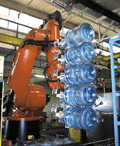The packaging industry has seen the future, and that is automated robots. Industrial robots are usually engaged in repetitive or even dangerous work. However, as robots become more and more efficient and the cost becomes lower and lower, today's packaging industry has increasingly depended on the flexibility and reliability of automatic robots to complete the work previously performed by conventional devices.
Looking at the relevant data, robots (especially packaging robots) are gaining rapid development. Statistics from the American Robotics Association show that compared to 2003, the number of robots used in the packaging and palletizing field increased by 50% in 2004, while the growth rate of the entire robotics industry was only 20%.
“Packers have high requirements for flexibility and rapid product transition,†explains Jeff Burnstein, vice president of marketing and public relations at the American Robotics Industry Association. “As more and more robots are used in these areas, end users We saw the effect and they hope to install more."
"We see the robot market is developing at a rapid pace, and its growth curve is a steep hockey stick shape," said Stuart Cooper, president of Langen Packaging. "In the past few years, about one-third of our business has been Traditional devices have turned to automatic robots."
The reason why robots can be used quickly is because of their flexibility. Packaging processors need to deal with a variety of product requirements from customers, and robots can handle products of different sizes and shapes more easily than traditional packaging equipment. For example, in a potato chip production line that may use two different sizes of packaging bags, the same robot can be used to complete the packaging production simply by adjusting the gripping unit and the setup procedure. Traditional packaging equipment may require a long product conversion process to complete the task.

One reason why robots are increasingly used in the packaging industry is that they are very good at handling heavier items.
“First and foremost, end-users want flexibility to meet their customers' requirements,†says LPMusunur, engineering manager at the palletizing and packaging division of Fanuc Robotics. “The same robot can handle bags, candy, For other various products, the cost that users need to obtain this flexibility is acceptable."
“More and more consumer products are sold in mixed form, especially in personal care products and consumer electronics products. This situation has played a big role in promoting the use of robots,†said Tim Tim, vice president of Adept Technology Corp. DeRosett said, “In the past, you could have used the same product for several weeks or months to produce the same product and then switched to other products. But now the time needed to switch production has been reduced to a few days. Even for a few hours, with very flexible robots, this conversion becomes very easy, usually only minor adjustments to tools and software. The robot still performs the same basic operations."
Users may place their own specific requirements on palletizing dimensions and the like. At this time, the flexibility of the robot can come in handy. For example, although most beverage companies use 36-by-36-inch pallets, Wal-Mart uses 48-by-48 inches as the standard size for pallets, which usually requires re-spinning of goods in logistics centers.
Reconfigurable assets
“For those who have traditional palletizing equipment, flexibility is becoming a problem, because these devices can only be applied to pallets of one size.†Sal Khan, president of AIDCO International, said, “When they consider adopting robots, They must be confident that these robots have the consistency, flexibility, and required throughput."
"The reason these users think about robots is to think of it as an asset that can be reconfigured," Cooper went on to say. "They can use the same robot to handle two or three different products. Then they can put this robot again. Arrange to other production lines."
Part of the convenience of product conversion is due to the rapid development of robot setup software. Today's robots can be reset very quickly and do not require excessive programming knowledge.
One of the outstanding advantages of today's robotics software is the use of offline settings and virtual functions. A process that normally takes the robot to spend 30 to 40 hours "learning" can now be "instructed" offline and then integrated into the system so that downtime can be as short as possible.
"Virtual features have been used for some time, but now we can provide models of other parts of the device so that users can reconfigure them and create processes automatically through templates," said Carl Traynor, senior marketing director at Motoman. Your palletizing robot needs to perform too many picking movements within an hour, you can use this function to verify, and then you may find that you need to change the palletizing mode. The virtual function can make the robot to perform the operation very accurately Simulate it."

Manufacturers of retail products that have multiple products or frequently introduce new products find the flexibility of robotic packaging equipment to be very attractive.
(to be continued)